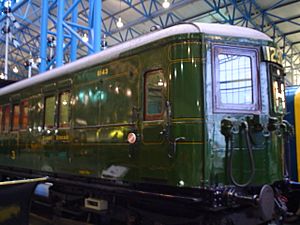British Rail Class 405 facts for kids
Quick facts for kids British Rail Class 405 |
|
|---|---|

4Sub Motor Car at National Railway Museum in York
|
|
| In service | 1925-1983 |
| Manufacturer | SR Eastleigh |
| Number built | Unknown |
| Formation | power car + 2 trailer cars + power car |
| Operator(s) | Southern Railway and British Railways |
| Specifications | |
| Maximum speed | 75mph 121km/h |
| Weight | DMBS - 39-43 tons |
| Prime mover(s) | Early units: 4 x 275 hp traction motors total 1,100 hp (821 kW) Later units: 4 x 250 hp traction motors total 1,000 hp (746 kW) |
| Braking system(s) | Air (Westinghouse) |
The British Rail Class 405, often called the 4-Sub, was a type of electric multiple unit train. These trains were used by the Southern Railway and later British Rail. They helped people travel around the busy inner-suburban areas of South London for many years.
Contents
What Were the "Sub" Trains?
The Southern Railway gave the name "Sub" to many different electric trains. These trains were designed for short journeys within the city suburbs. They were perfect for carrying lots of passengers on busy routes.
When they were first built, these trains had three cars linked together. This meant they had one power car and two trailer cars.
How the "Sub" Trains Changed
In the 1940s, the railway needed to carry even more people. So, all the "Sub" trains that were still in use were made longer. An extra trailer car was added to each train, making them four cars long.
New four-car trains were also built around this time. These newer, longer trains were very important for daily travel in London.
Life on the Tracks: The Class 405
The four-car "Sub" trains served passengers for a very long time. They were a common sight on the tracks until late 1983. By then, British Rail had given them an official number: Class 405.
These reliable trains helped millions of people get to work, school, and other places. They were a key part of London's transport system for decades.
Images for kids



